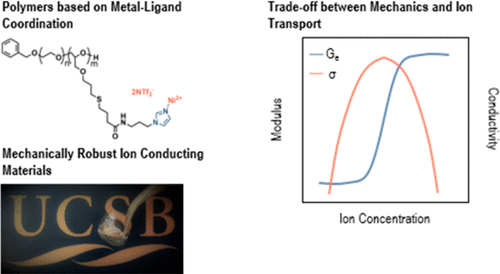当前位置:
X-MOL 学术
›
Macromolecules
›
论文详情
Our official English website, www.x-mol.net, welcomes your
feedback! (Note: you will need to create a separate account there.)
Ion Transport in Dynamic Polymer Networks Based on Metal–Ligand Coordination: Effect of Cross-Linker Concentration
Macromolecules ( IF 5.1 ) Pub Date : 2018-02-27 00:00:00 , DOI: 10.1021/acs.macromol.7b02141 Gabriel E. Sanoja 1 , Nicole S. Schauser , Joshua M. Bartels , Christopher M. Evans , Matthew E. Helgeson , Ram Seshadri , Rachel A. Segalman
Macromolecules ( IF 5.1 ) Pub Date : 2018-02-27 00:00:00 , DOI: 10.1021/acs.macromol.7b02141 Gabriel E. Sanoja 1 , Nicole S. Schauser , Joshua M. Bartels , Christopher M. Evans , Matthew E. Helgeson , Ram Seshadri , Rachel A. Segalman
Affiliation

|
The development of high-performance ion conducting polymers requires a comprehensive multiscale understanding of the connection between ion–polymer associations, ionic conductivity, and polymer mechanics. We present polymer networks based on dynamic metal–ligand coordination as model systems to illustrate this relationship. The molecular design of these materials allows for precise and independent control over the nature and concentration of ligand and metal, which are molecular properties critical for bulk ion conduction and polymer mechanics. The model system investigated, inspired by polymerized ionic liquids, is composed of poly(ethylene oxide) with tethered imidazole moieties that facilitate dissociation upon incorporation of nickel(II) bis(trifluoromethylsulfonyl)imide. Nickel–imidazole interactions physically cross-link the polymer, increase the number of elastically active strands, and dramatically enhance the modulus. In addition, a maximum in ionic conductivity is observed due to the competing effects of increasing ion concentration and decreasing ion mobility upon network formation. The simultaneous enhancement of conducting and mechanical properties within a specific concentration regime demonstrates a promising pathway for the development of mechanically robust ion conducting polymers.
中文翻译:

基于金属-配体配位的动态聚合物网络中的离子传输:交联剂浓度的影响
高性能离子导电聚合物的发展需要对离子-聚合物缔合,离子电导率和聚合物力学之间的联系有一个全面的多尺度理解。我们提出了基于动态金属-配体配位的聚合物网络作为模型系统来说明这种关系。这些材料的分子设计允许对配体和金属的性质和浓度进行精确和独立的控制,这对于本体离子传导和聚合物力学至关重要。受聚合离子液体的启发,所研究的模型系统由聚氧乙烯和带束缚的咪唑基团组成,这些咪唑基团可在掺入镍(II)双(三氟甲基磺酰基)酰亚胺时促进离解。镍-咪唑相互作用可物理交联聚合物,增加弹性活性股的数量,并显着提高模量。另外,由于在形成网络时增加离子浓度和降低离子迁移率的竞争效应,观察到最大的离子电导率。在特定浓度范围内同时增强导电性能和机械性能证明了开发机械强度高的离子导电聚合物的有前途的途径。
更新日期:2018-02-27
中文翻译:

基于金属-配体配位的动态聚合物网络中的离子传输:交联剂浓度的影响
高性能离子导电聚合物的发展需要对离子-聚合物缔合,离子电导率和聚合物力学之间的联系有一个全面的多尺度理解。我们提出了基于动态金属-配体配位的聚合物网络作为模型系统来说明这种关系。这些材料的分子设计允许对配体和金属的性质和浓度进行精确和独立的控制,这对于本体离子传导和聚合物力学至关重要。受聚合离子液体的启发,所研究的模型系统由聚氧乙烯和带束缚的咪唑基团组成,这些咪唑基团可在掺入镍(II)双(三氟甲基磺酰基)酰亚胺时促进离解。镍-咪唑相互作用可物理交联聚合物,增加弹性活性股的数量,并显着提高模量。另外,由于在形成网络时增加离子浓度和降低离子迁移率的竞争效应,观察到最大的离子电导率。在特定浓度范围内同时增强导电性能和机械性能证明了开发机械强度高的离子导电聚合物的有前途的途径。











































 京公网安备 11010802027423号
京公网安备 11010802027423号